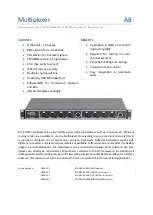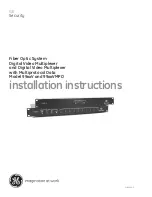
6
AC CURRENT MEASUREMENT
CAUTION:
Do not make current measurements on the 10 A scale for
longer than 30 seconds. Exceeding 30 seconds may cause damage to the
meter and/or the test leads.
1. Insert the black test lead plug into the negative (COM) socket.
2. For current measurements up to 10 A, set the function switch to the A
position and insert the red test lead plug into the (10 A) jack.
3. For current measurements up to 400 mA, set the function switch to the
mA range and insert the red test lead plug into the (mA) jack.
4. For current measurements up to 10 A AC, set the function switch to the
A position and insert the red test lead plug into the 10 A jack.
5. Press the MODE button. The measurement mode will change between
AC or DC as required.
6. Remove power from the circuit under test, then open up the circuit at
the point where you wish to measure current.
7. Connect the black test probe to the negative side of the circuit. Connect
the red test probe to the positive side of the circuit.
8. Apply power to the circuit. Read the current in the display. The display
will indicate the proper decimal point, value and symbol.
11. Remove power from circuit before disconnecting test leads
RESISTANCE [
Ω
] MEASUREMENT
WARNING:
To avoid electric shock, disconnect power to the unit under
test and discharge all capacitors before taking any resistance
measurements. Remove the batteries and unplug the line cords.
1. Set the function switch to the
Ω
position.
2. Insert the black test lead plug into the negative (COM) socket and the
red test lead plug into the positive
Ω
jack.
3. Connect the test probe tips across the circuit or part under test. It is
best to disconnect one side of the part under test so the rest of the
circuit will not interfere with the resistance reading.
4. Read the resistance in the display. The display will indicate the proper
decimal point, value and symbol.
CONTINUITY CHECK
WARNING:
To avoid electric shock, never measure continuity on circuits
or wires that have voltage on them.
1. Set the range switch to the
Ω
position.
2. Insert the black lead plug into the COM socket and the red test lead
plug into the positive socket.
3. Connect the test probe tips to the circuit or wire you wish to check.
4. If the resistance is less than 30
Ω
, the audible signal will sound. The
display will also show the actual resistance in ohms.
DIODE TEST
WARNING:
To avoid electric shock, do not test any diode that has voltage
on it.
1. Set the function switch
to the position.
2. Insert the black test lead plug into the COM socket and the red test lead
plug into the
socket.
3. Connect the test probe tips to the diode or semiconductor junction you
wish to test. Note the meter reading.
4. Reverse the probe polarity by switching probe position. Note this
reading.
Содержание AVO300 Series
Страница 13: ...13 M Multim tres num riques S rie AVO300 MANUAL DE L UTILISATEUR...
Страница 25: ...26...
Страница 26: ...27 M Digitale Multimeter der AVO300 Serie BEDIENUNGSANLEITUNG...
Страница 39: ...40...
Страница 40: ...41 M Mult metros Digitales Serie AVO300 MANUAL DEL USUARIO...
Страница 52: ......







































